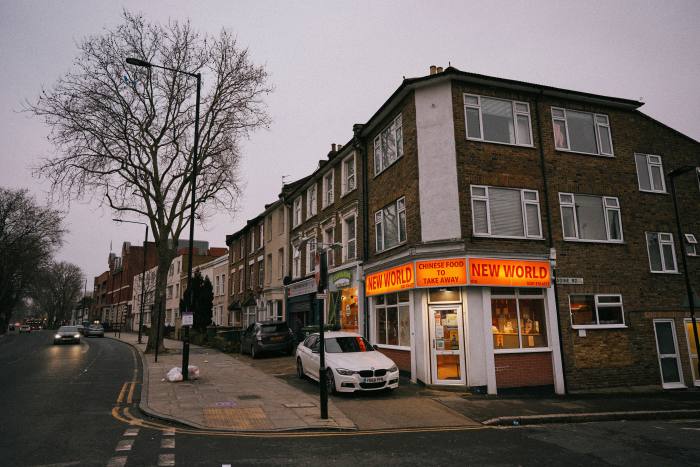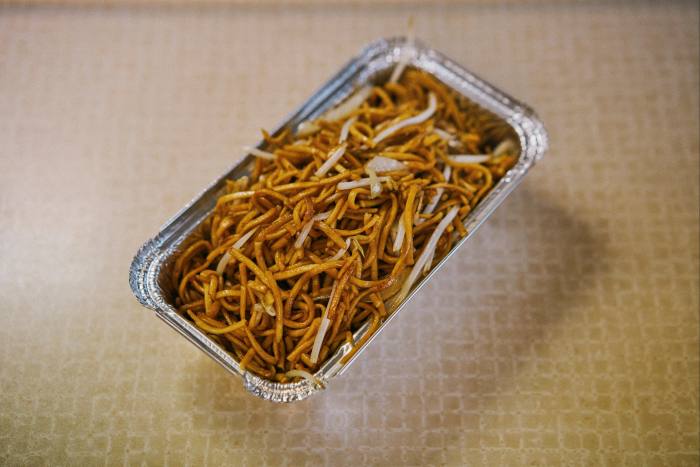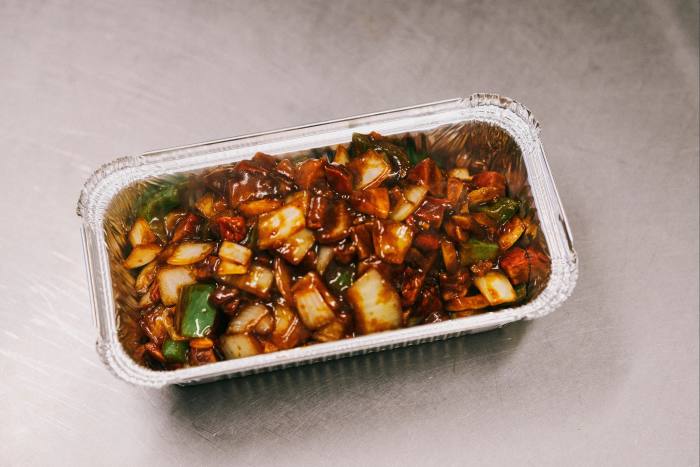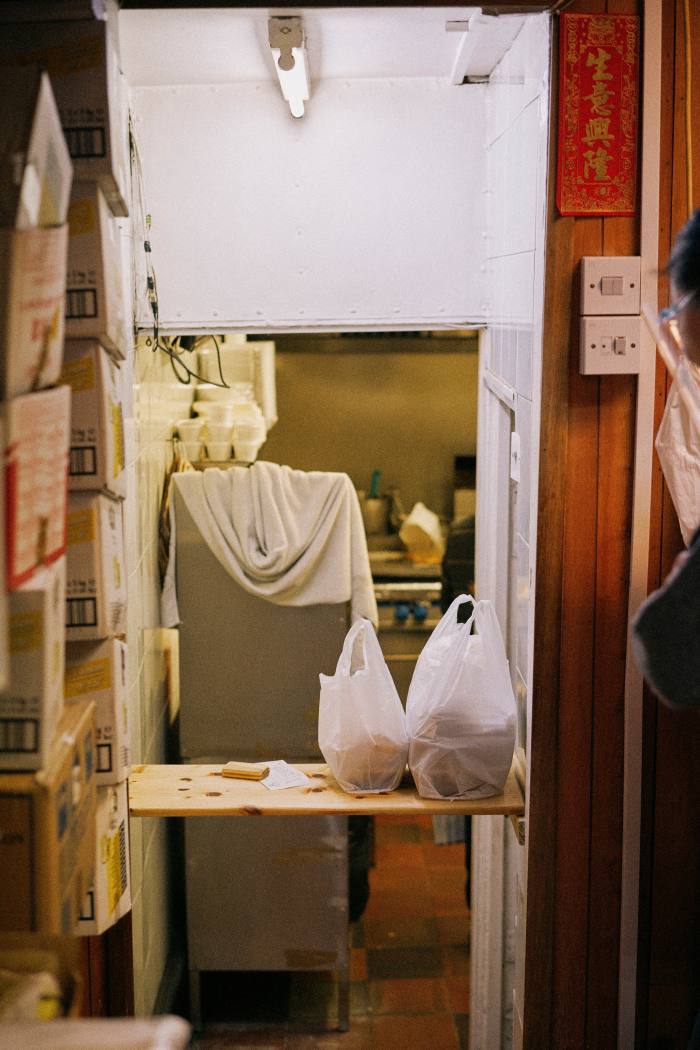In the New World Chinese takeaway in Plaistow, east London, Julie Tang was gossiping with her customers in a broad Cockney accent. A woman leant on the counter, discussing her various marriages. An elderly man came in, beaming, for some food and a chat. The telephone rang constantly and a stream of people popped in to pick up orders in hot foil containers stacked in brown paper bags.
“Hello, Barbara, yes, you’ll pick up in 20 mins?” said Tang on the phone. A few Chinese lanterns hung from the ceiling of the otherwise spartan room. Everyone seemed to be on first-name terms with Tang, who filled the space with the warm glow of kindness and welcome, like the beloved landlady of a neighbourhood pub.
If 2020 was the year of the pandemic, it was also the year of takeaway food, and 2021 may be the same. With restaurants either closed or constrained by the rules of social distancing, home cooking and meal deliveries came into their own.
Takeaways no longer just meant pizza or cheap food in plastic boxes, but anything you could imagine, from Malaysian laksa to English pies, from meals to meal kits, from the affordable to the astronomical, delivered to every sofa in the land. Hunkered down in Dalston, I enjoyed everything from Turkish kebabs and fish and chips to a white-truffle tasting menu that arrived in a multitude of boxes with two pages of instructions.
Amid this wild kaleidoscope of culinary choices, it’s easy to forget that the takeaway was once almost synonymous with Chinese food. In the 1970s, when I was growing up in Oxford, the only takeaways available, aside from fish and chips, were Chinese and Indian.
On rare occasions, to the delight of my sister and me, our parents would pick up a Chinese meal: spring rolls, sweet-and-sour pork balls with a polystyrene cupful of bright red sauce and a stack of foil boxes filled with fried rice and chop suey. We would grapple with the unfamiliar chopsticks and eagerly devour the food.
According to accounts cited by author Barclay Price, the Chinese takeaway was born in the postwar years, when customers asked to take food home from the popular Lotus House in Bayswater; others believe that it was invented at a Limehouse restaurant, Local Friends. In any case, the idea took off with the arrival of a wave of immigrants from Hong Kong’s New Territories.
Most takeaways were Chinese outposts in largely white communities, offering mildly exotic food to Brits more accustomed to eating shepherd’s pie, and many appeared when Chinese families took over former fish-and-chip shops, which may be why chips — often with curry sauce — became a fixture on their menus.


According to Gregor Benton and Edmund Terence Gomez in their book The Chinese in Britain, 1800-Present, at the start of the 1950s, there were just 36 Chinese restaurants in the UK but, in competition with the new fast-food chains, Chinese takeaways sprang up all over the country in the 1970s and 1980s. By 1971, they were opening at the rate of three a week; by the late 1990s, they numbered about 5,000 nationally. In just two decades, the Chinese takeaway had become a British institution.
The food on offer was far removed from what Chinese people ate themselves: there were no broths, bones or shells, few vegetables and far too much deep-frying. With no access to fresh Chinese produce, takeaways relied on tinned bamboo shoots and water chestnuts, as well as beansprouts grown from dried mung beans. Fresh peppers and onions offered the requisite crunch; flavours were childishly appealing.
The formula, loosely based on Cantonese cooking but simplified for western tastes and modest budgets, had been pioneered by Chinese immigrants in America. It was the only Chinese food most British people ever ate. Despite its almost total lack of authenticity, it was a wild success. By 2001, according to a report by Market Intelligence, Chinese was the British people’s favourite foreign food.
Half a century after it first conquered British palates, the “traditional” British Chinese takeaway has been drowned out by the clamour of other cuisines and a new wave of more authentic Chinese specialities. Most of the elder generation of Cantonese chefs have retired, their locally born children leaving behind the rattle of ladles in woks and the hiss of steam.
Supermarket Chinese ready meals, often featuring favourite takeaway dishes, have encroached on the old takeaway market. Anyway, why eat chop suey, an ersatz dish invented for Americans, when you can enjoy biang biang noodles made by a native of Xi’an or real Sichuanese mapo tofu?
After my childhood delight in sweet-and-sour pork balls, I largely forgot about the old-school Chinese takeaway. I went to live in China and became accustomed to eating real Chinese food. Only once, for journalistic reasons, did I order a meal from a random north London takeaway and I must have picked badly because it was so poor it destroyed all my childhood memories: rancid oil, leathery meat. It wasn’t an experience I wanted to repeat. But that was until I stumbled across Julie Tang’s New World on the Barking Road.


I was on the trail of an old London Chinese dish, Jar Jow, a speciality of the city’s original Chinatown near the Limehouse Docks. I remembered it from my early days as a restaurant reviewer in the 1990s, when a couple of faded restaurants in Limehouse still served it: a mixture of chopped pork and vegetables in a dark, sweet sauce.
Rumour had it that it was the legacy of Cantonese or Shanghainese dockworkers who had settled in Limehouse in the late 18th and early 19th centuries. I was curious about the dish and hoped that, if I could discover its Chinese name, I could work out its origins in some Chinese regional cuisine.
But Limehouse is no longer a Chinese neighbourhood. During the second world war, the district was devastated by German bombing; afterwards, Hong Kong immigrants started laying the foundations of a new Chinatown in Soho. By the late 1990s, all that remained of Chinese Limehouse was a commemorative dragon sculpture and a couple of Chinese restaurants. Now even those establishments have been swept away by a tide of artisan pizzerias, trendy coffee shops and craft breweries.


Internet digging suggested that the only place in London where Jar Jow was still available was the New World, a few miles from Limehouse. And so I ended up driving out to Plaistow for a Chinese takeaway. It was a nondescript-looking place, but as soon as I entered it was clear it was special. The menu was a throwback to the 1970s (with Jar Jow as a bonus), the place was filled with enticing smells, the customers all clearly loved it, and then there was the amiable Julie Tang, with whom I quickly fell into conversation.
Tang is a born-and-bred Londoner, the daughter of Hong Kong immigrants who ran a Chinese takeaway during her teenage years. She married into another Chinese takeaway family, and she and her husband took over this business, then known as Lam’s House, in 1996. The menu has barely changed since. “We’ve added a few dishes, like crispy duck,” she says, “But the main items on the menu remain the same, because it works.” The repertoire is a roll-call of classic Anglo-Canto fare: chop sueys, chow meins, fried rices, curries, sweet-and-sours, prawn crackers and “English dishes” that include roast chicken and various omelettes with chips.
“Probably 60 per cent of our customers are white British and among the rest there are now a lot of eastern Europeans,” says Tang. “The white British love their chicken chow mein, special fried rice, sweet and sour chicken balls, chips in curry sauce and chicken curry. We do have a few Chinese customers, but they order what, for me, are more traditional dishes, like boiled rice, Hong Kong-style sweet-and-sour pork and Singapore noodles; they never order chop suey.”
Many of her customers have been coming here not only for years, but for generations. “I’ve known kids who have now got kids of their own and they still come. And even people who moved out to Essex 15 years ago still come back, once or twice a week,” she says.


In the back kitchen, the Fujianese head chef, Xue Jingong, who has been working for the business for 28 years, showed me how to make Jar Jow. In a small wok, he stir-fried slices of char siu pork and a few pork scratchings in oil, then tipped in sliced bamboo shoot, onion and green pepper. A brief sizzle, then he added water, chilli powder, tomato paste, seasonings. Finally, he thickened the sauce with starch and turned everything into a foil container. With its dark soy-sauce sheen and sliced bamboo shoot, the dish looked Chinese-ish, if not Chinese. It had a definite chilli kick.
Tang and Xue told me its Chinese name, which didn’t help me deduce its origins. Xue admitted he didn’t eat Jar Jow himself. According to Tang, however, the dish still has a loyal following in east London: “Lots of people order it, young and old, we have several orders every night.” Outside east London, no one’s heard of it.
Later, I drove home with my own stack of foil containers, brimming with delicious smells. It was my first Anglo-Chinese takeaway in decades, and I was filled with nostalgic glee. Here were the sweet-and-sour pork balls of my childhood, piping hot and quite irresistible, each golden globe stuffed with a nugget of tender meat and eaten with a trickle of clear, mandarin-coloured sauce. The pancake rolls were just as I remembered them: great floppy things packed with juicy beansprouts, shot through with morsels of char siu pork.
And then there were chips with their home-made curry sauce, which Tang insisted I try, and special chop suey — as stubbornly unfashionable as you’d expect: neither western nor Chinese, but a mixture of chopped pork, chicken, shrimps, onions, beansprouts and peas in a sloppy tomato sauce, with a small omelette on top.
My visit to the New World brought me no closer to understanding the roots of Jar Jow, but it did offer me a joyful reunion with my childhood recollections. Banished were all thoughts of rancid oil and leathery meat. This was the easy, lovely, robustly inauthentic Chinese food I had adored as a child, deftly cooked and served with an endearing generosity of spirit. It was a reminder that British Chinese food, like London itself and all its polyglot cuisines, tells tales of people on the move, past and present.
Jar Jow, that strange hybrid, had early on been eclipsed by chop sueys and chow meins. Now even these dishes had become endangered species, replaced in the nation’s affections first by crispy duck with pancakes and now by a whole plethora of regional dishes.


The almost total disappearance of the Chinese and their old Jar Jow from Limehouse is also a reminder that the history of immigration is an evolving palimpsest of tastes and stories, layered one on top of another, each one erasing the one before it, reminding us all of our ephemerality.
People and dishes come and go. Immigration, gentrification, white flight, hipsterfication, urban decay, war and urban renewal all redraw the maps of cities. It’s a process that is fraught with emotion but usually futile to resist. Our claims on land, space and palates are fragile and fleeting.
New World (also known as Lam’s House)
410 Barking Road, London E13 8HJ; +44 20 7476 6577
Fuchsia Dunlop is the author, most recently, of “The Food of Sichuan”, and winner of the Fortnum & Mason 2020 cookbook award
Follow @FTMag on Twitter to find out about our latest stories first.
